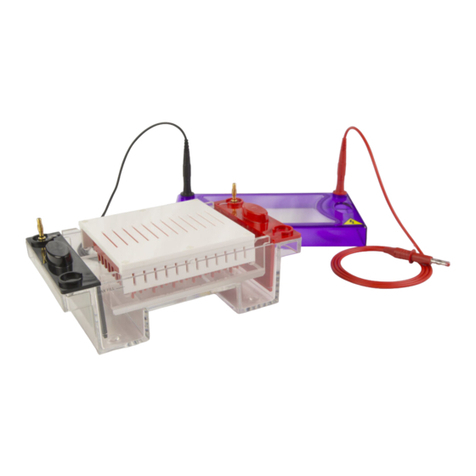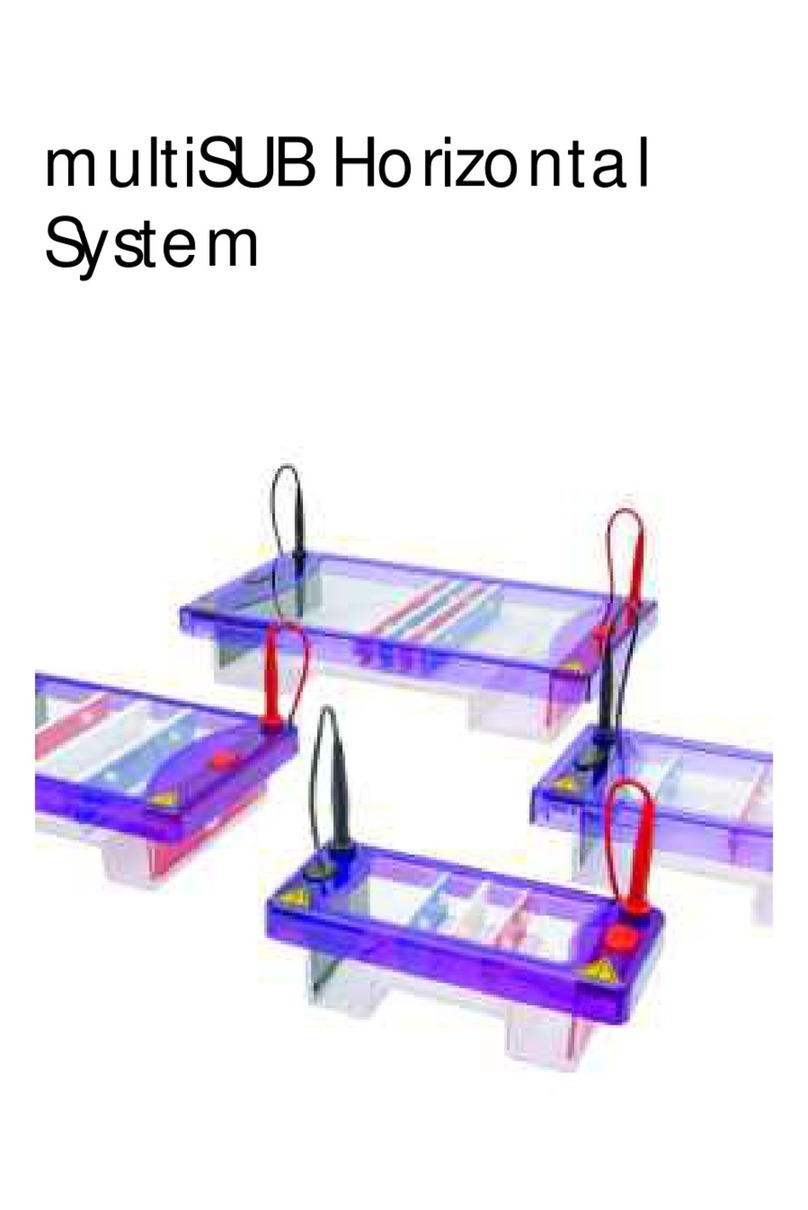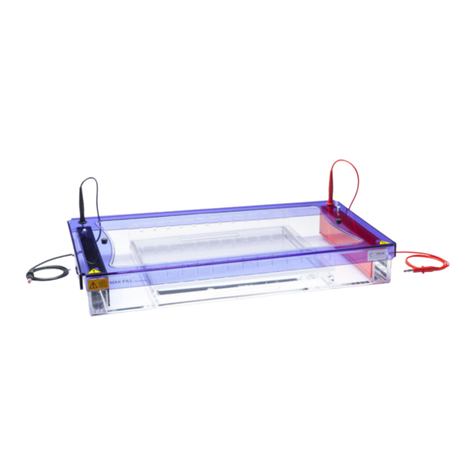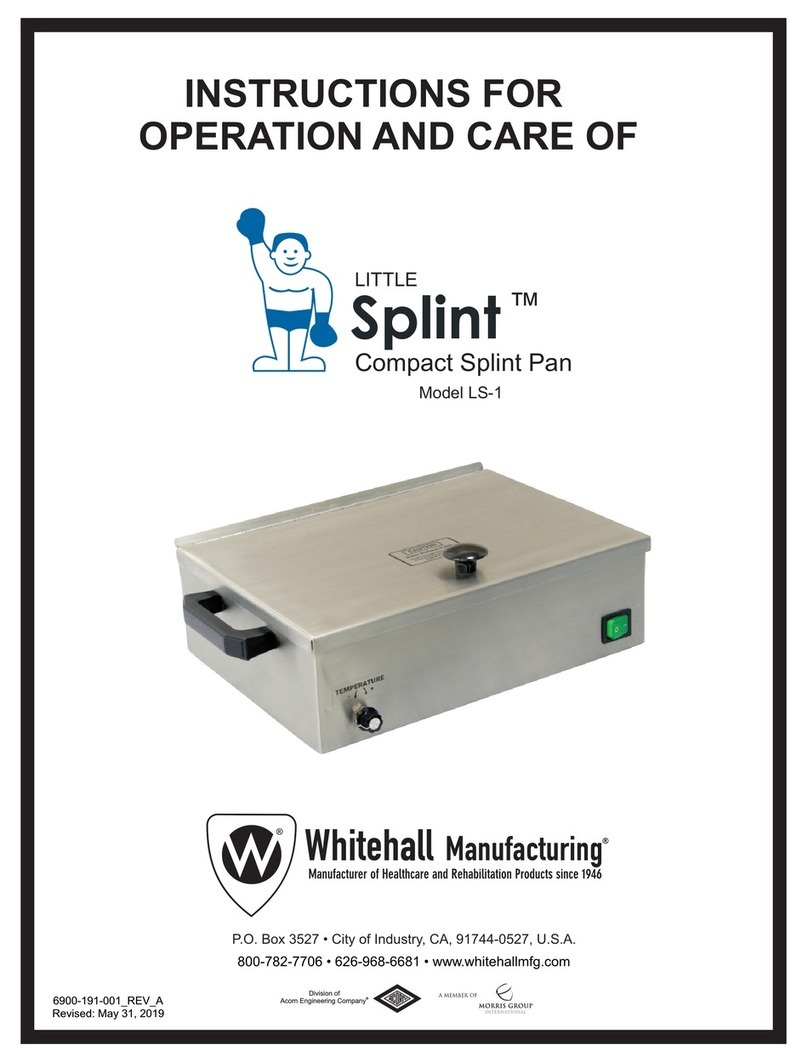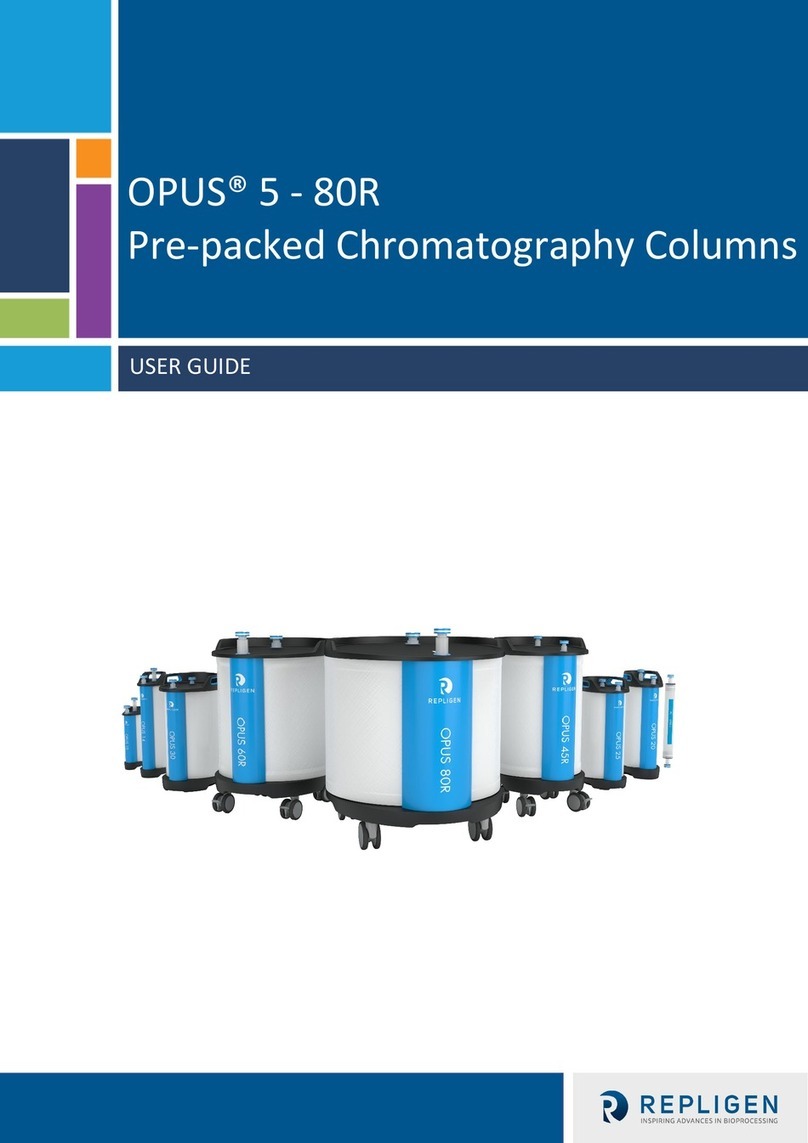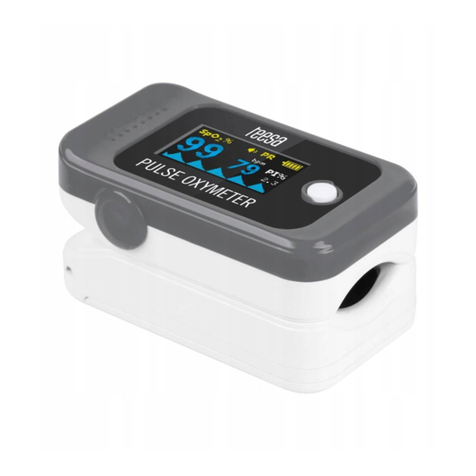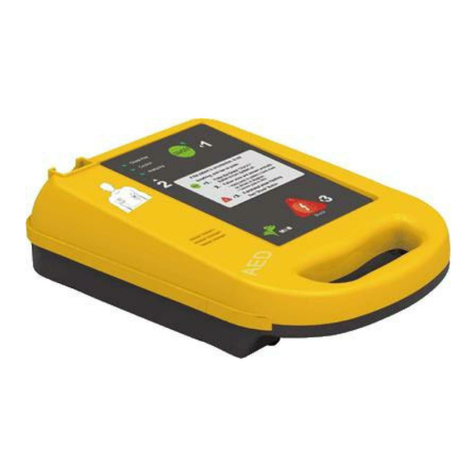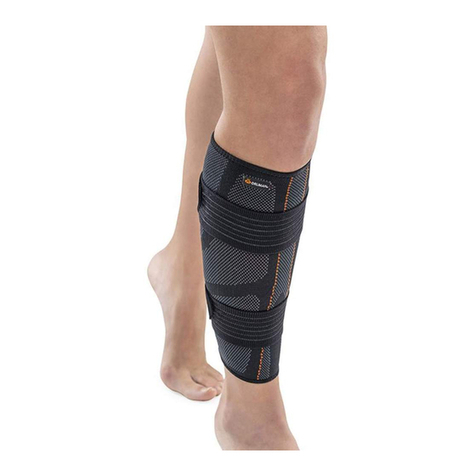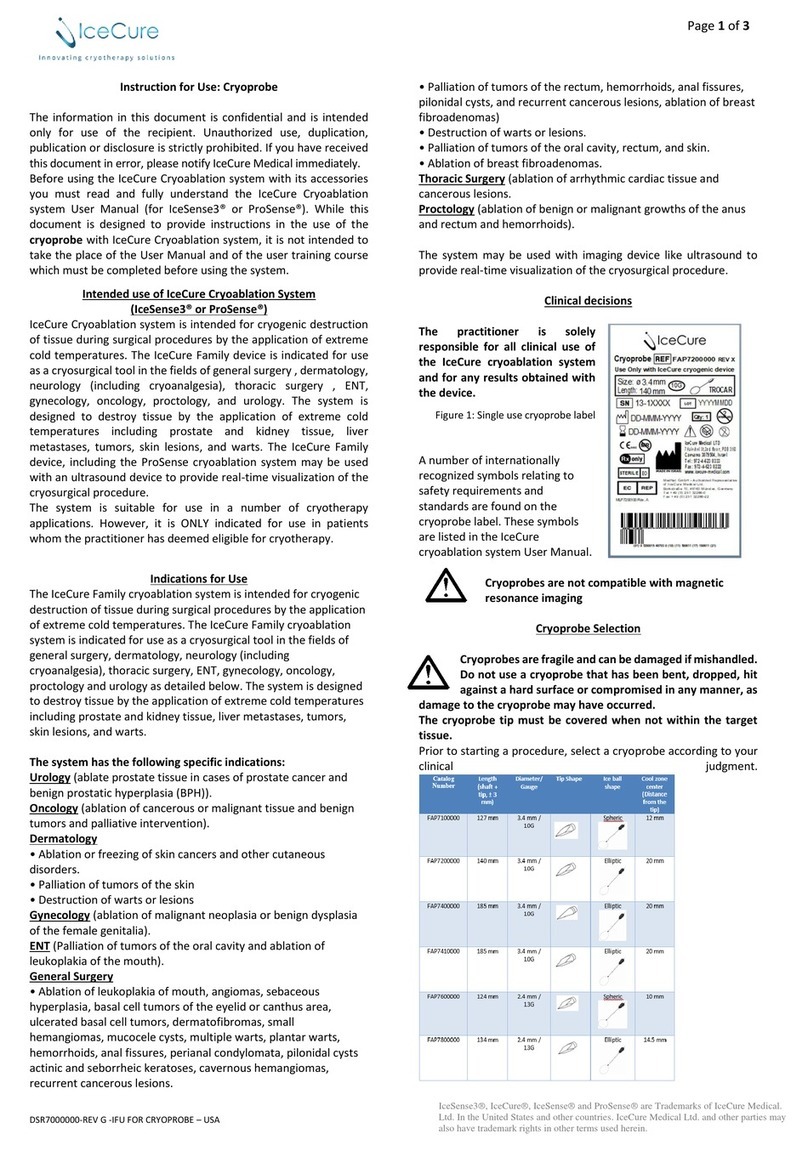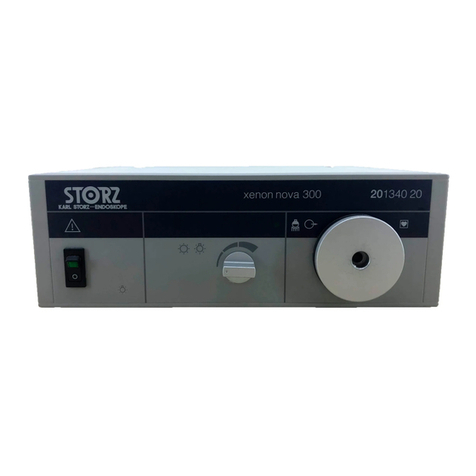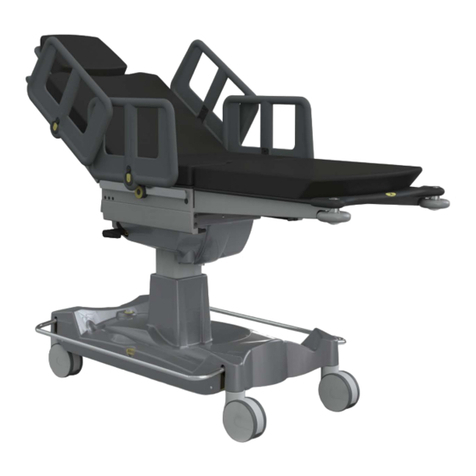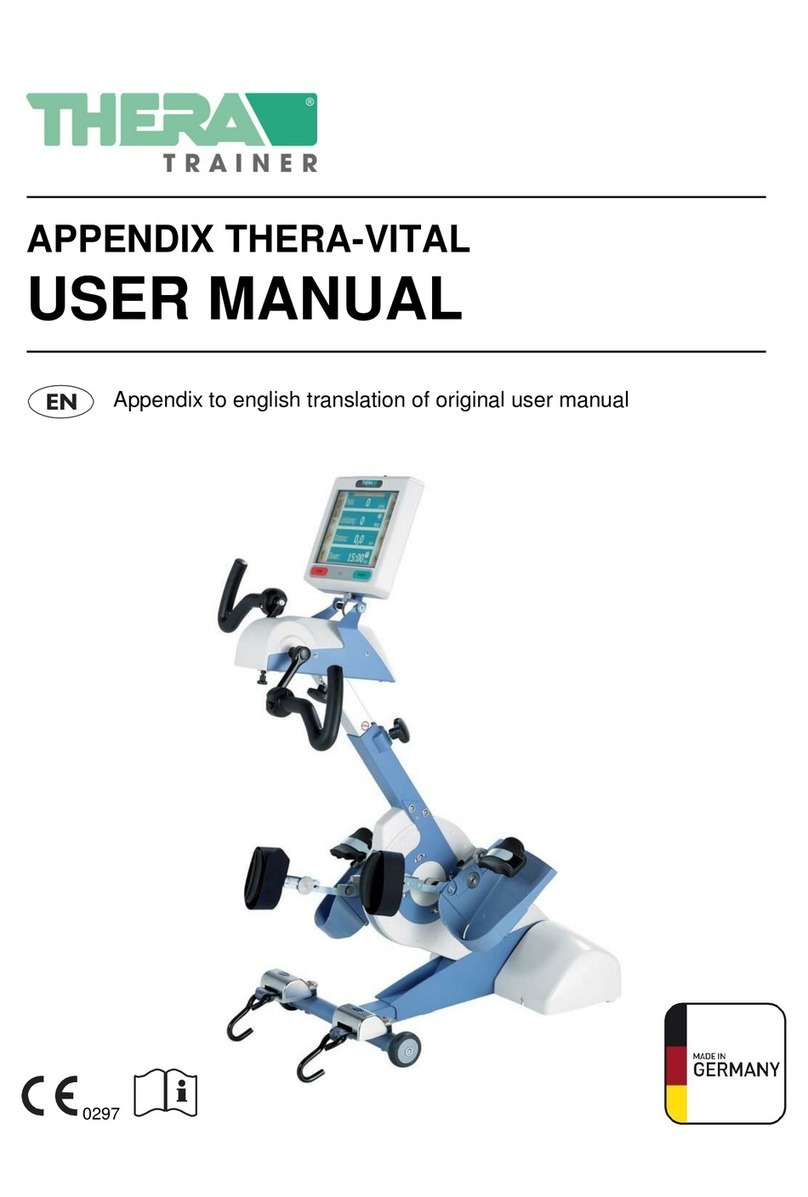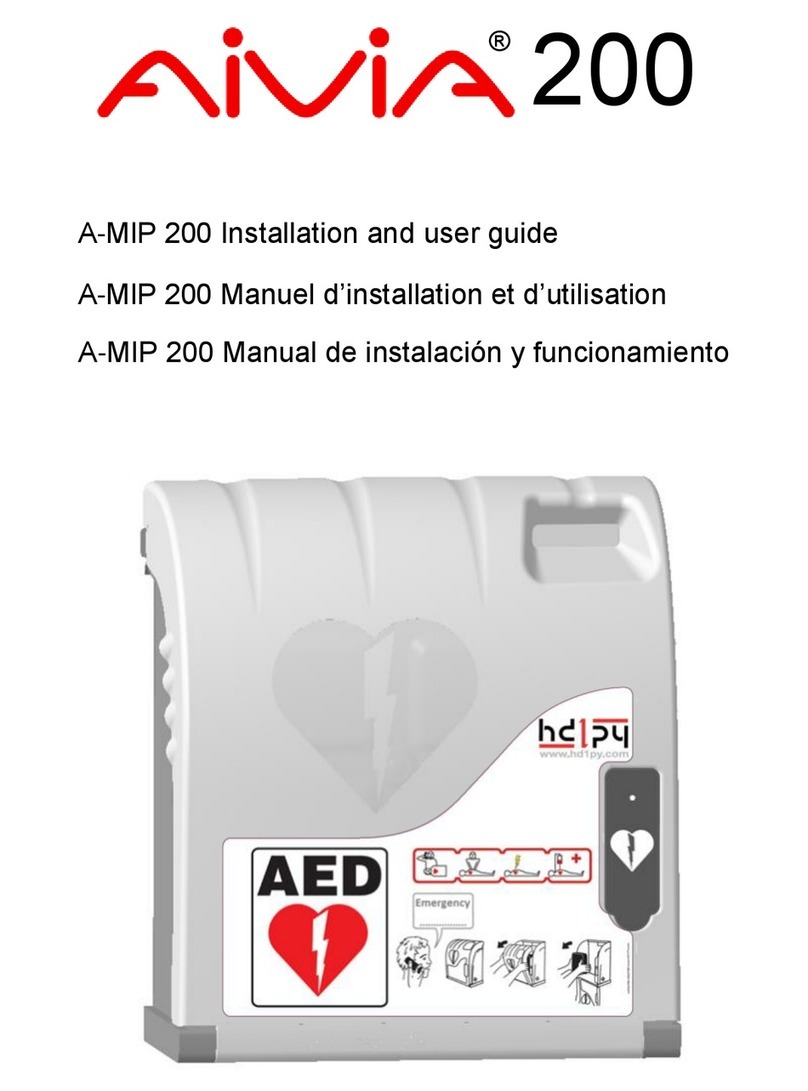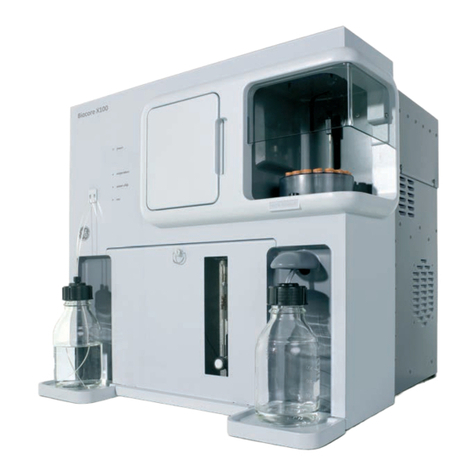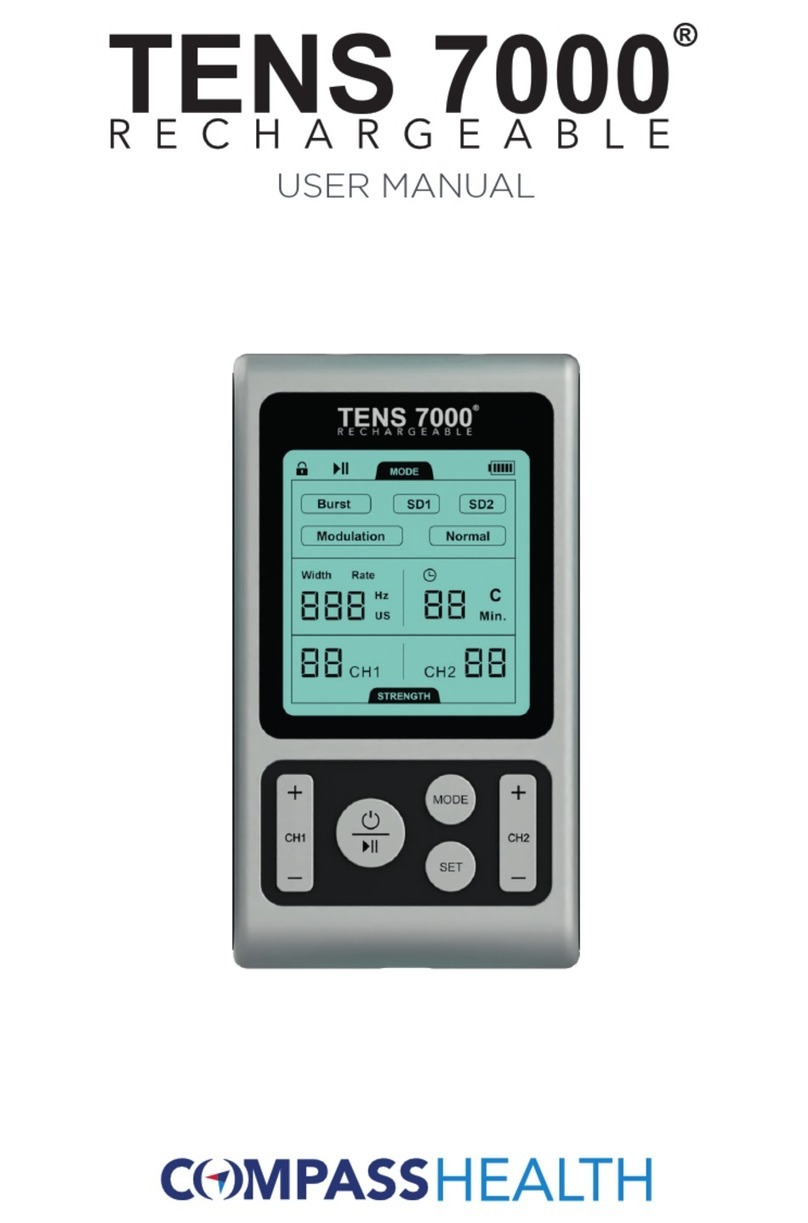Cleaver Scientific CVS10CBS User manual

02/09/2021 Page 1
omniPAGE Mini
Vertical
Electrophoresis and
Electroblotting Units
Instruction Manual
Catalogue Numbers
CVS10CBS SB10
Record the following for your records:
Model _____________________
Catalogue No. _____________________
Date of Delivery _____________________
Warranty Period _____________________
Serial No. _____________________
Invoice No. _____________________
Purchase Order No. _____________________

2
Contents
Instruction Manual 1
Catalogue Numbers 1
Contents 2
Safety Information 3
Packing List 4
Care and Maintenance 5
Operating Instructions 6
Usage Guidance and restrictions 6
Setting up the Gel Tanks 6
Protein Electrophoresis 7
Casting Unit Preparation 7
Gel Preparation 9
Preparation of denatured protein samples for loading 11
Gel Pouring 11
Gel Running 14
Protein Blotting 16
Setting up the blot sandwich 16
Blot Running Conditions 17
Solutions 19
References 21
Troubleshooting 22
Warranty 28

3
Safety Information
When used correctly, these units pose no health risk. However, these units
can deliver dangerous levels of electricity and are to be operated only by
qualified personnel following the guidelines laid out in this instruction manual.
Anyone intending to use this equipment should read the complete manual
thoroughly. The unit must never be used without the safety lid correctly in
position. The unit should not be used if there is any sign of damage to the
external tank or lid.
Acrylamide is a powerful neurotoxin in solution form. Polymerized gels can
contain some unpolymerized solution and protective gloves and clothing
must be worn.
These units comply with the following European directives:
2006/95/CE Low Voltage Directive and 2014/30/UE (official Title 2004/108/EC)
EMC Electromagnetic Compatibility
By virtue of the following harmonised standards:
BS EN IEC 61010-1: 2010 Safety Testing of Lab Equipment
BS EN IEC 61326-1:2013 EMC Electro Magnetic Compatibility

4
Packing List
Each Units include tank, lid, cables and the following items:
SKU
Inner inserts
Glass Plates
Combs
Caster
Cooling
Pack
Extra
CVS10CBS
CVS10DIRM -
omniPAGE
Mini
VS10BI -
omniBLOT Mini
VS10NG –Notched,
Pk/2
VS10PGS1 –Plain with
bonded 1mm spacers,
Pk/2
VS10-DP –Dummy
Plate
2 of VS10-12-1
1mm thick, 12
sample
VS10DCAST
VS10ICB
VS10-SCREW x
4
CSL-
WBROLLER
SB10
VS10BI -
omniBLOT Mini
Includes:
4 of SB10C
Cassettes
2 of SB10F,
Fibre pads
Pk/8
VS10ICB
CSL-
WBROLLER
Packing List Checked by: ________________________
Date: ________________________
The packing lists should be referred to as soon as the units are received to
ensure that all components have been included. The unit should be checked
for damage when received.
Cleaver Scientific is liable for all missing or damaged parts / accessories
within 7 days after customers have received this instrument package. Please
contact Cleaver Scientific immediately regarding this issue. If no response
within such period is received from the customer, Cleaver Scientific will no
longer be liable for replacement/damaged parts.
Please contact your supplier if there are any problems or missing items.

5
Care and Maintenance
Cleaning the Unit
Units are best cleaned using warm water and a mild detergent. Water at temperatures
above 600 C can cause damage to the unit and components.
The tank should be thoroughly rinsed with warm water or distilled water to prevent build
up of salts but care should be taken not to damage the enclosed electrode and vigorous
cleaning is not necessary or advised.
Air drying is preferably before use.
The units should only be cleaned with the following:
Warm water with a mild concentration of soap or other mild detergent.
Compatible detergents include dishwashing liquid, Hexane and Aliphatic hydrocarbons
The units should not be left to in detergents for more than 30 minutes.
The units should never come into contact with the following cleaning agents, these will
cause irreversible and accumulative damage:-
Acetone, Phenol, Chloroform, Carbon tetrachloride, Methanol, Ethanol, Isopropyl alcohol
Alkalis.
RNase Decontamination
This can be performed using the following protocol:-
Clean the units with a mild detergent as described above.
Wash with 3% hydrogen peroxide (H2O2) for 10 minutes.
Rinsed with 0.1% DEPC- (diethyl pyrocarbonate) treated distilled water,
Caution: DEPC is a suspected carcinogen. Always take the necessary precautions when
using. RNaseZAP™ (Ambion) can also be used. Please consult the instructions for use with
acrylic gel tanks.

6
Operating Instructions
Further information (including videos) regarding setting up and running the
omniPAGE units can be found at www.cleaverscientific.com
Usage Guidance and restrictions:
• Maximum altitude 2,000m.
• Temperature range between 4°C and 65°C.
• Maximum relative humidity 80% for temperatures up to 31OC decreasing linearly to 50%
relative humidity at 40OC.
• Not for outdoor Use.
This apparatus is rated POLLUTION DEGREE 2 in accordance with IEC 664.
POLLUTION DEGREE 2, states that: “Normally only non-conductive pollution occurs.
Occasionally, however, a temporary conductivity caused by condensation must be
expected”.
Setting up the Gel Tanks
Note: Before setting up the Gel Tank please ensure that it has been properly cleaned and
dried.
1. Note the position of the lid on the unit. This shows the correct polarity
and the correct orientation of the cables, black is negative and red
positive.
2. Remove the lid from the unit.
Note: If the lid is not removed, fitting the cables may result in un-tightening of the gold
plug and damage the electrode.
3. Screw the cables into the tapped holes as fully as possible so that there
is no gap between the lid and the leading edge of the cable fitting.
4. Refit the lid and the unit is now ready to be used.
The unit is now ready to be used.

7
Protein electrophoresis
Casting Unit Preparation
Cleaning the Glass Plates
Clean a set of glass plates for each gel first with distilled water and then with
70 % ethanol. One set of glass plates constitutes one notched glass plate
and one plain glass plate with bonded spacers.
When using a triple glass plate sandwich, two notched glass plates are
required, one set of free spacers and a set of plain glass plates with bonded
spacers. The plain glass plate is positioned outermost, then a notched glass
plate, free spacers and second notched glass plate. Alternatively, accessory
notch glass plates with bonded spacers are available.
Note: All glass plates, gel casting modules, casting base and accessories must be
completely dry before the set –up. Wet components are more likely to miss-align and
cause leaks.
Gel Cassette Assembly
Assemble the glass plates in the CVS10DRIM casting/running insert so that the
bottom of the glass plates and the spacers are perfectly aligned on a flat
levelled surface (i.e. laboratory bench –outside the casting base).
A triple plate sandwich can be used by combining the standard Notched
plate and spacer plate, with an additional notched plate with spacers. For
triple plate sandwiches, the free spacers Need to be perfectly aligned which
is best performed using a small spacer or comb to push the spacers apart.
Notched glass plates with bonded spacers do not need manual alignment.
NOTE: If only one gel needs to be casted, please make sure to use the
dummy plate on the other side otherwise the casting/running insert won’t be
straight.
Casting Stand Assembly
1. Ensure that the pressure bars are adequately open for the thickness of
spacer used. The bar can be opened by loosening the screws or by
sliding the clamps. When using a triple glass plate sandwich, the

8
pressure bars will need to be in the completely open position and it is
advise to use the screws clamping system instead of the clamps.
2. Position the Slab Gel Insert on a flat surface. Insert the glass plates into
the Slab Gel Insert between the pressure bar and the blue gasket. The
Slab Gel Insert contains pressure bars which impart even pressure onto
the glass plates and allow even screw pressure transfer onto the
sealing edge of the glass plate, ensuring complete sealing.
3. Fully tighten the screws, making sure not to wobble the unit. When using
the Slide Clamp Mini version, simply slide both gates outwards until fully
tightened. When only one gel is being run, the dummy plate must be
used in the second position and fully tightened.
NOTE: At this stage, check that the bottom edges of the spacers and glass plates are
perfectly aligned.
4. Position the Slab Gel Insert in the casting base such that the Cam pins
have handles pointing downwards and are located in the insert holes.
The top of the module may need to be pushed down very slightly to
locate the cam pins by placing a gloved hand horizontally between
both glass sandwiches.
5. With the cam pin handles facing directly downwards, turn the cam pins
fully through 135° or until the insert has tightened onto the silicone mat.

9
NOTE: It is best to turn the cams in opposite directions to each other. Do not overturn as
this will cause the glass plates to push upwards and the assembly will be more likely to
leak. The unit is now ready for gel preparation and pouring.
Always reverse the silicone mat after casting to avoid indentations from persisting. Never
leave the casting up-stand with glass plates tightened into the casting base for long
periods of time as this will also cause indentations in the silicone mat.
The slide clamp version omniPAGE Mini also includes screws. This system can be used
either with the slide clamps or screws as preferred by the user. For those that prefer to use
the screws rather than clamps, the screws can be simply inserted into the screw holes. The
clamps can be removed by placing each clamp in the fully open position and gently
bending the clamp upwards from the slanted end. The holding pin will then slowly release,
and the clamp can be removed. Screw based casting is required when using the triple
sandwich plate method.
Gel Preparation
Care should be taken when selecting the pore size of the gel to be used. The
pore size or % of gel determines the resolving ability given different sizes of
protein.
Gel percentage for various protein sizes are shown below:
Acrylamide Percentage
Separating Resolution
5 %
60 - 220 KD
7.5 %
30 - 120 KD
10 %
20 - 75 KD
12%
17 –65 KD
15 %
15 -45 KD
17.5%
12 –30 KD

10
Gel Volumes for the omniPAGE Mini Unit are shown below:
Number of gels
Gel Thickness (mm)
Volume (ml)
Single –one gel, one
dummy plate
0.5
1.0
1.5
2.0
3.8
7.5
11.3
15.0
Double –two gels
0.5
1.0
1.5
2.0
7.5
15.0
22.5
30.0
Using a Triple Plate
sandwich –four gels
0.5
1.0
1.5
2.0
10.0
30.0
45.0
60.0
Prepare gel solutions as per tables below. These give the volumes of solutions
from the standard stock solutions. These should be gently mixed avoiding
generation of bubbles which will inhibit polymerization by removing free
radicals.
Resolving Gel, for 2 x 1mm thick gels:
Solution
5 %
7.5%
10 %
12%
15 %
17.5%
Distilled Water
8.7ml
7.5ml
6.3ml
5.25ml
3.75ml
2.5ml
30 % Stock Acrylamide
Solution
2.5ml
3.75ml
5ml
6ml
7.5ml
8.75ml
4 X Resolving Tris Solution
3.75ml
3.75ml
3.75ml
3.75ml
3.75ml
3.75ml
Add 15 µl of TEMED and 150µl 10 % Ammonium Persulphate to the resolving
gel solution before pouring to initiate polymerisation

11
Stacking Gel:
Solution
Volume
Distilled Water
4.2ml
30 % Stock Acrylamide Solution
0.65ml
4 X Stacking Gel Tris Solution
1.6ml
Add 67µl of 10 % Ammonium Persulphate and 6.7µl TEMED before pouring.
Preparation of denatured protein samples for loading
The instructions given below are for denatured samples. For Native samples,
please consult a laboratory handbook.
1. Prepare the protein samples for loading. The volume of sample
depends on the capacity of the wells
2. Using a 0.5 ml micro-centrifuge tube or other convenient receptacle,
combine the protein sample and 4 X sample buffer. It is always
advisable to use protein markers in one of the end lanes to indicate
sizes of bands. These should be prepared according to the
manufacturer’s instructions.
3. Heat the samples in a water bath or heating block for 2 minutes to
denature the samples.
4. Centrifuge the samples in a micro-centrifuge for 20 seconds at 12,000
rpm. The protein samples are now ready to load.
Gel Pouring
Casting a gel with stacking layer
1. Place a comb into the gel cassette assembly with any gel and mark
the glass plate below the comb teeth. This is the reference level to
which the resolving gel should be poured.
2. Prepare the resolving gel solution. Mix well and avoid generating air
bubbles.

12
3. Fill the glass plates smoothly till the mark avoiding generating any air
bubbles. Filling must be performed quickly before the TEMED causes
the gel to become too viscous.
4. Overlay the gel extremely carefully with 1 ml of Isobutanol, Isopropanol
or distilled water. When using distilled water extra care must be taken
to ensure there is no mixing with the gel solution.
5. Let the resolving gel polymerize. Usually this takes around 15 to 30
minutes, but this can vary due to the freshness of the reagents used. If
polymerization is taken a lot longer than this, use fresher stock solutions
or add more APS and TEMED.
6. Let the resolving gel polymerize. Usually this takes around 15 to 30
minutes, but this can vary due to the freshness of the reagents used. If
polymerization is taken a lot longer than this, use fresher stock solutions
or add more APS and TEMED.
7. Prepare the stacking gel solution.
8. Before casting the stacking gel, insert a piece of filter paper to dry the
area in between the glass plates above the resolving gel. Take care
not to touch the surface of the gel.
9. Carefully pour the stacking gel solution, avoiding generating air
bubbles.
10. Carefully insert the comb making sure that no air bubbles get trapped
under the ends of the comb teeth as these will inhibit sample
progression.
11. Allow the stacking gel to polymerize.
12. Once the gel is polymerized it is ready for the electrophoresis run.
Casting a gel without stacking layer
•Prepare the resolving gel solution. Mix well and avoid generating air
bubbles.
•Pour the solution smoothly into the glass plates avoiding any air bubbles
until the top of the notched glass plate is reached.
•Carefully insert the comb making sure that no air bubbles get trapped
under the ends of the comb teeth as these will inhibit sample
progression.

13
•Let the gel polymerize. Usually this takes from 15 to 30 minutes, but this
can vary due to the freshness of the reagents used. If polymerization is
taken a lot longer than this, use fresher stock solutions or add more APS
and TEMED.
•Once the gel is polymerized it is ready for the electrophoresis run.
Using Precast Gels
1. omniPAGE mini is compatible with all the precast gels available in the
market.
2. Simply remove the precast gel from the storage pouch.
3. Gently remove the comb.
4. Keep the Inner module upstand on a flat surface and place the
precast gel between the pressure bar and the blue gasket.
omniPAGE tank assembly and Sample loading
1. If desired, fit the cooling pack(s) into the end of the tank. These should
be pre-frozen and fitted with the longest side positioned sideways with
the end(s) of the tank and pressed into the recess. Or these can be
fitted down the front of the tank.
Note: NEVER FIT THESE UNDERNEATH THE MODULE IN THE BOTTOM OF THE TANK AS THIS WILL
PREVENT THE FLOW OF CURRENT THROUGH THE GEL AND CAUSE SLOW RUNS AND OVER-
HEATING.
Note one pack is supplied as standard. Additional packs can be purchased.
2. Transfer the Inner gel module containing cast gels into the main tank in
the correct orientation as indicated - +ve on the module aligned with
+ve on the tank, -ve on the module aligned with –ve on the tank.
3. Fill the outer tank with 1X reservoir buffer. See “Solutions” for
recommended running buffer solution.
4. Load the samples into the wells using a pipette tip taking care not to
damage the wells or induce any air bubbles.
5. Fill any unused wells with 1 X sample buffer.
6. It is a good idea to note the orientation and order the samples were
loaded in. This can be done by noting which samples were loaded
adjacent to each electrode.

14
Buffer Volume
omniPAGE mini vertical
Minimum –Inner tank is filled to above gel level.
Outer Tank is filled to just flood the bottom of the glass
plates. Cooling potential is at a minimum which may
affect resolution.
250ml
Maximum –Inner tank is filled to above gel level.
Outer Tank is filled to the maximum fill line. Cooling is
high offering good resolution of samples.
1200ml
Using the cooling packs –Inner tank is filled to above
gel level.
Cooling packs are inserted behind the gels. Outer
Tank is filled to the maximum fill line. Cooling is at a
maximum.
1000ml
Gel Running
1. Fit the lid and connect to a power supply.
2. Gels should be run at constant voltage, with voltage dependent on
the size of the proteins undergoing separation. An initial setting of 100V
with constant observation of migration and heat production is
recommended. An exploratory study may be required to determine
the optimal settings for individual proteins.
Suggested Voltages and Resultant Current
for 1mm thick, 12% gels.
omniPAGE mini vertical
One gel
90-225V
20-45mA
Two gels
90-225V

15
40-90mA
Three gels
90-225V
60-135mA
Four gels
90-225V
80-180mA
Gel Removal
1. Turn the power supply off when the loading dye reaches the bottom
of the gel, sooner if your proteins are below 4 kDa in size.
2. Remove the gel running module, first emptying the inner buffer into the
main tank. Buffer can be re-used but this may affect run quality if
continued.
3. Unscrew the glass plates with the Screw version. To open the sliding
door version, insert the CSLKEY into the recess arch of the clamping
door. Twist key applying pressure to both the clamping door and the
CVS10D side cheek. The door will now click open. Repeat this process
until you have opened both the doors.
4. Remove the glass plates. Then using CSLKEY separate notched and
the plain glass plates. Place the wedged end of the key between the
two plates and gently twist until the plates pull apart. The gel will
usually stick to one of the plates and can be removed by first soaking
in buffer and then gently lifting with a spatula.
5. The gel is now ready to be stained with Coomassie or silver stain or the
proteins in the gel can be transferred to a membrane by
electroblotting for specific band identification and further analysis.

16
Protein Blotting
Setting up the blot sandwich
N.B Remember to always wear gloves when dealing with proteins to avoid
contaminations!
1. Following electrophoresis, remove the glass plate and transfer the gel
into Transfer buffer.
2. Equilibrate the gel between 10-30min at room temperature on a shaker
according to specific protocols.
3. Cut the membrane to the same size of the gel and equilibrate in
Transfer buffer as well.
NOTE: It is best to assemble the blotting sandwich in some transfer buffer to
avoid the membrane to dry out and trapped bubble should be removed with
a roller at each step during blotting sandwich assembly
1. Each blot sandwich should be set up according to the following order:
- Cassette clamp -ve (black) side placed in a tray or other suitable
container
- Pre-soaked fibre pad. Note two can be used with thin gels.
- Two pieces of thick filter paper, about 2 –3 mm thick, pre-soaked in
buffer.
- Gel.
- Transfer membrane. Usually this requires pre-soaking but consult the
manufacturer’s instructions for the type of membrane you are using. This
should be smoothed so that no air bubbles have been trapped.
- Two pieces of thick filter paper, about 2 –3 mm thick, pre-soaked in
buffer.
- Pre-soaked fibre pad. Note two can be used with thin gels.
- Cassette clamp +ve (red).

17
2. Close the cassettes hinge carefully to not disturb the sandwich.
3. Fill the tank with buffer solution up to the maximum fill line indicated on
the side of each unit. See recommended buffer solutions section.
NOTE: Improved transfer can usually be obtained by using chilled buffer.
Buffer Volume
SB10
One Cassette
Two Cassettes
Three Cassettes
Four Cassettes
1380ml
1290ml
1200ml
1110ml
Each Cooling pack will take the place of ~ 100ml of buffer
Blot Running Conditions
1. Insert the cassettes into the slots in the VS10BI blotting module with the
black side of each adjacent to the negative electrode. It is a good
idea to note the orientation and order the blot sandwiches were
loaded in. This can be done by noting which samples were loaded
adjacent to each electrode and by marking the membrane with a
pencil on one corner.
2. Use of a magnetic stirring bar and plate is recommended to mix the
buffer to give consistency of transfer. A 4mm diameter stirring bar
should be placed underneath the module, in the centre of the tank.
The Cooling pack provided, pre-frozen, can be inserted at the side or
front of the tank for extended blots. Additional cooling packs can be
purchased as accessories to further aid cooling.
3. Insert the blotting module in the tank making sure the polarity is correct,
fit the lid and connect to a power supply.
4. Consult Suggested Running Condition for recommended power supply
voltage settings and blot times. Please note voltages and current will

18
vary according to the number of cassettes, type and temperature of
buffer and thickness and percentage of gel. This will also affect quality
of transfer so time course of transfer should be performed for your
particular samples and conditions.
5. When the blot time is completed, turn the power supply off.
6. Remove the cassettes from the main tank. Buffer can be re-used but
this may affect run quality if continued.
7. Lift the hinge of each cassette and gently pry apart the blot sandwich
and remove the membrane from the gel.
8. The membrane is now ready to be probed.
Suggested Running Conditions (please note that these are just guideline)
Duration of Blot
SB10
One Hours
Three Hours
Overnight ~16 hr
100V –125V
~ 250mA - 400mA
50V
~ 200mA
10 V
30–40 mA
N.B. If the voltage is held constant throughout a transfer, the current in most
transfer systems increases as the resistance drops due to heating. Therefore,
the overall power increases during transfer, and more heating occurs.
Despite the increased risk of heating, a constant voltage ensures that field
strength remains constant, providing the most efficient transfer possible for
tank blotting methods. Use of the cooling elements available with the various
tank blotting systems should prevent problems with heating.

19
Solutions
Stock 30% Acrylamide Gel Solution:-
30.0 g acrylamide
0.8 g methylene bisacrylamide
Distilled Water to 100ml
Stock 4 X Resolving Gel Tris (1.5 M Tris.HCl pH8.8, 0.4 % SDS)
To 110ml Distilled Water add 36.4 g of Tris base
Add 8ml of 10 % SDS
Adjust pH to 8.8 with 1N HCl
Adjust the final volume to 200ml with Distilled Water.
Stock 4 X Stacking Tris (0.5 M Tris.HCL pH6.8, 0.4 % SDS)
To 110ml Distilled Water add 12.12 g of Tris base
Add 8ml of 10 % SDS
Adjust pH to 6.8 with 1N HCl
Add Distilled Water to a final volume of 200ml
Stock 4 X Tris-glycine tank buffer - SDS
36 g Tris base
172.8 g glycine
Distilled Water to 3 L
1 x Tris-glycine tank buffer - SDS
750ml of 4 X Tris-glycine reservoir buffer - SDS
30ml of 10 % SDS
Distilled Water to 3L
10 % AP (ammonium persulphate solution)
0.1 g ammonium persulphate

20
1ml Distilled Water
TEMED ready solution
Stock 4 X Sample Buffer
4ml glycerol
2ml 2-mercaptoethanol
1.2 g SDS
5ml 4 X Stacking Tris
0.03 g Bromophenol blue
Aliquot into 1.5ml microcentrifuge tubes. Store at -20°C.
Towbin Buffer
25mM Tris,
192mM glycine,
20% methanol pH8.3,
Towbin Buffer SDS
25mM Tris
192mM glycine
20% methanol pH8.3
0.05-0.1% (w/v) SDS
Bjerrum and Schafer-Nielsen Buffer
48mM Tris
39mM glycine
20% methanol pH9.2
Dunn Buffer
10mM NaHCO3
3mM NaCO3
20% methanol pH9.9
This manual suits for next models
1
Table of contents
Other Cleaver Scientific Medical Equipment manuals
